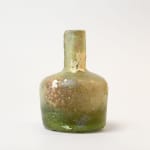Early Islamic Glass Bottle, 700 CE - 900 CE
Glass
height 7.6 cm
height 3 in
height 3 in
G.0209
The advent of Islam in the seventh century and the empire created by its adherents had little immediate impact on glass production. In the Eastern Mediterranean Classical-Byzantine forms and techniques...
The advent of Islam in the seventh century and the empire created by its adherents had little immediate impact on glass production. In the Eastern Mediterranean Classical-Byzantine forms and techniques continued to be practised, whilst further east Parthian-Sassanian traditions prevailed. By the late eighth century however it is possible to discern a distinctively 'Islamic' style of glass. Cultural ties across the empire and the migration of craftsmen from one area to another helped to fuse Classical and Near-Eastern traditions. Whilst it is certainly true that one of the characteristic features of Islamic glass is the emphasis on decoration, undecorated vessels of great beauty were also created. Many of these were used for everyday purposes by the urban population- as tableware, containers for oils and perfumes, storage vessels, oil lamps and even for scientific and medicinal equipment.
This small bottle has a cylindrical neck, a flat shoulder and a slightly squat globular body with a flat base. A wonderful iridescent patina, caused by weathering over the centuries, covers the surface of the pale green glass. (AM)
This small bottle has a cylindrical neck, a flat shoulder and a slightly squat globular body with a flat base. A wonderful iridescent patina, caused by weathering over the centuries, covers the surface of the pale green glass. (AM)



